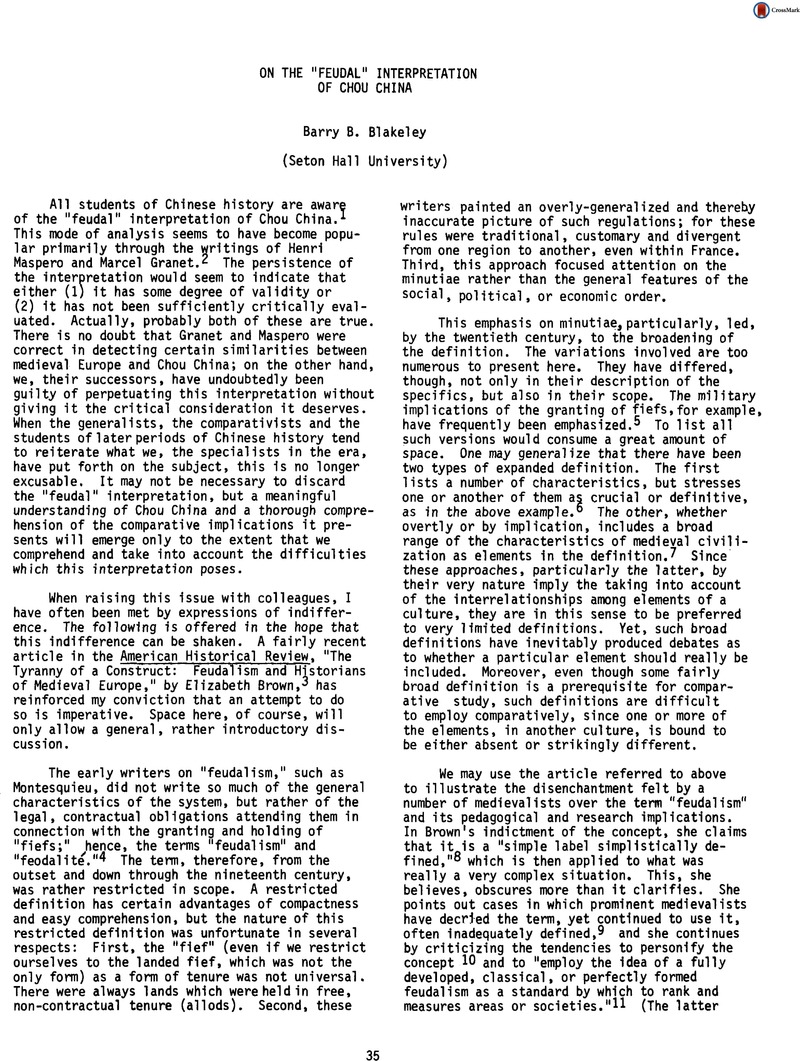Article contents
On the “Feudal” Interpretation of Chou China
Published online by Cambridge University Press: 26 March 2015
Abstract

- Type
- Review Articles
- Information
- Copyright
- Copyright © Society for the Study of Early China 1976
References
FOOTNOTES
1. In this entire discussion I am deleting consideration of the Marxist “feudal” interpretation. There is little room for debate over the definition of the term in Marxist circles.
2. Maspero, Henri, Les Institutions de la Chine, ed. Escarra, Jean (Paris, 1952)Google Scholar and “Le régime féodal et la propriété foncière dans la Chine antique,” Mélanges posthumes sur les religions et l'histoire de la Chine” Vol. III (Paris, 1950)Google Scholar; Granet, Marcel, La Féodalité Chinoise (Oslo, 1952)Google Scholar.
3. AHR 79, no. 4 (10 1974), pp. 1063–1088 Google Scholar. For an early discussion of the topic, see Cronne, H.A., “Historical Revisions XCI--The Origins of Feudalism,” History 24 (1940), pp. 251–259 CrossRefGoogle Scholar.
4. Bloch, Marc, Feudal Society, trans. Manyor, L.A. (Chicago, 1961), xvii–xviii Google Scholar.
5. Ibid., p. xiii
6. See, for example, Stephenson, Carl, “The Origin and Significance of Feudalism” AHR 46 (1941), pp. 797–808 Google Scholar; Ganshof, Francois L., Feudalism, trans. Grierson, P. (London, 1952), xvi Google Scholar; Vinogradoff, Paul, “Feudalism,” The Cambridge Medieval History, Volo III (New York, 1922), pp. 458–450Google Scholar.
7. Bloch, op. cit.; Weber, Max, The Theory of Social and Economic Organization, trans. Henderson, A. and Parsons, T. (New York, 1947), pp. 373–381 Google Scholar and General Economic History, trans. Knight, F. (Glencoe, Ill., 1950), pp. 51–115 Google Scholar.
8. Brown, op. cit., p. 1065.
9. Ibid., pp. 1065-67.
10. Ibid., p. 1075.
11. Ibid., p. 1076.
12. Ibid., p. 1077.
13. Ibid., pp. 1080-1084.
14. Ibid., pp. 1067-1070, 1077, 1079-1080.
15. Princeton University Press, 1956.
16. “Feudalism in Japan--A Reassessment,” Comparative Studies in Society and History 5.1 (10 1962), pp. 15–51 CrossRefGoogle Scholar. Reprinted in Hall, John W. and Jansen, Marius B., eds., Studies in the Institutional History of Early Modern Japan (Princeton, 1968)Google Scholar.
17. “Regional Aspects of Chinese Socio-Political Development in the Spring and Autumn Period (771-464 B.C.): Clan Power in a Segmentary State.” PhD. dissertation, University of Michigan, 1970 Google Scholar.
18. “Chinese Feudalism During the Ch'un-ch'iu Period.” PhD. dissertation, Harvard University, 1935 Google Scholar.
19. “Feudalism in China,” in Coulborn, op. cit., pp. 49-92.
20. The Origins of Statecraft in China. Vol. 1: The Western Chou Empire (Chicago, London, 1970), p. 32. n. 10Google Scholar; See also my review, HJAS 23 (1973), pp. 249–250 Google Scholar.
21. Walker, Richard L., The Multi-State System of Ancient China (Hamden, Conn., 1953)Google Scholar.
22. Creel, op. cit.; Ch'i, op. cit.
- 1
- Cited by




